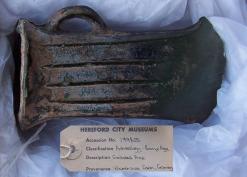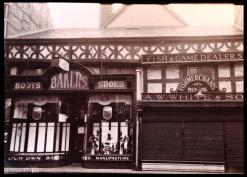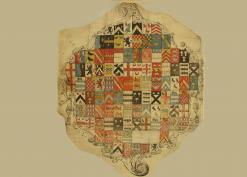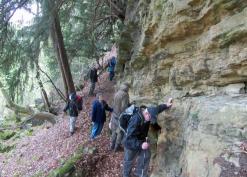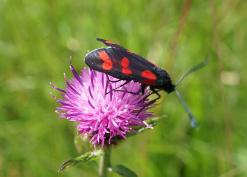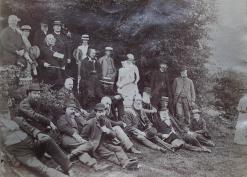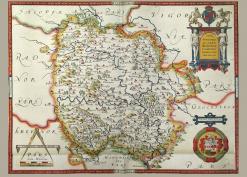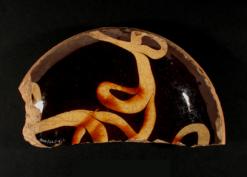Update on the Woolhope Room and Library
As reported in the Club newsletter No. 50 for Spring 2025, it eventually proved necessary to remove all of the collections in the Club library to safe storage during the redevelopment of the Broad Street building. Securing this outcome was a top priority for the Club and was achieved in January 2025 with the input of many members, and in crucial partnership with Rhys Griffiths and his team at HARC and with Damian Etheraads and the Museum team. The Club is most grateful to all who took part in protecting assets of great value to the Club and the public alike.
We look forward to re-opening and to welcoming members and researchers once more, with facilities improved as part of the programme to reinvigorate the museum and create a cultural hub in the centre of Hereford.
Update on the Woolhope Room and Library
As usual, the Woolhope Club Library will be open every Thursday in June 2023 until 29 June.
The whole building is due to close in mid July, so that Thursday 29 June will be the last day of opening until the project to redevelop the Museum is completed. This will give the Club librarians time to ensure that everything within the library is packed away safely before we have to leave.
The books and documents held within the library and the Woolhope Room itself will be carefully protected during the major development work. We look forward to re-opening and to welcoming members and researchers once more, with facilities improved as part of the programme to reinvigorate the museum and create a cultural hub in the centre of Hereford.
Woolhope Room Exhibition July 15-August 31 2022
The Woolhope Club's Room located in Hereford's Central Library is open to the public for an exhibition. Two subjects are covered: the story of the river Wye and the Herefordshire Hoard. A poster advertising the exhibition can be found here. The Story of the Wye exhibition is displayed on large loards around the room. A view or download of this exhibition is available here, Please enlarge some of the images to take in valuable detail.
Herefordshire Hoard
*** On 6 August the fund-raisubg total was reached!*** The Herefordshire Hoard is a collection of coins and jewellery found in a field in 2015. The funds were being raised to bring it back to Herefordshire and display it in the museum. The Herefordshire Council website has detailed pictures of the finds at https://www.herefordshirehoard.org.
Hearth Taxes: 1665 and 1671 (Wormelow) loaded
1665 Hearth Tax: This was transcribed by John Hornden from a film in Herefordshire archives. He also produced a personal names index. From these he published a typescript, copies of which are held at the archives, at the National Archives and at the Society of Genealogists. This has been photographed and the page images made available. on the website. The names index is available as a single file which can be downloaded. From this the images for each hundred can be browsed and a search for individual pages made using the website's Search mechanism on the Home Page. Some work still has to be done linking individual page images to a total list of the individual pages but this is not essential to the searcher. The 1665 Hearth Tax can be found by going to topic People>Person Taxation>Hearth Taxes>1665 Hearth Tax or by clicking here.
1671 Hearth Tax for Wormelow: This was transcribed for Matthews' continuation volume of Duncumb's history of Herefordshire. It was published in 1912. You can go to it via People>Person Taxation>Hearth Taxes>1671 Hearth Tax Wormelow or by clicking here.
Mycology: Mary Lloyd Wynne & Alfred Osten Walker
An important new paper by Dr John Edmondson is now available in our digital Transactions Extra format on the Club website. To access the paper, entitled ‘Mary Lloyd Wynne of Coed Coch and Alfred Osten Walker of Colwyn Bay: two little known mycologists from North Wales’ please:
1. Use this link: https://www.woolhopeclub.org.uk/publications/transactions-extra
2. Click on the underlined title of the paper near the top of the page
The paper brings alive the contribution of both mycologists and their role in the network which developed the science in the second half of the 19th century. Leading figures of the day feature throughout, whilst fungi found, and species discovered, are described from various sources. The paper is particularly well illustrated, with photographs of key people, fine paintings of fungi, some by Mary Lloyd Wynne, and an extraordinary cartoon of the ‘Hereford Fungus Festival’ of 1874.
There are frequent connections with the Woolhope Club since the ground-breaking fungus forays, introduced by Dr H. G. Bull, attracted leading mycologists and gave the Club a prominent role. Mary Lloyd Wynne attended several forays in Herefordshire and, in 1880, invited Dr Bull and a Woolhope party to join a remarkable foray at her home, Coed Coch in Denbighshire. The content relating to the Club complements Edward Blackwell's enlightening piece of 2010 - 'Henry Graves Bull, fungologist and father of the Fungus Foray’, TWNFC 58 (2010), pp. 95-126 - from a different perspective.
We are delighted to publish Dr Edmondson’s paper, in time for his address to the 125th anniversary conference of the British Mycological Society on 5 April. Dr Edmondson was formerly head of botany, then science, at Liverpool World Museum, part of National Museums, Liverpool, and is now an honorary research associate at the Royal Botanic Gardens, Kew. A more detailed biography will be published in the 2021 Transactions.
Gillian Bulmer and 'When Dr Hogg went to Hereford'
The Gillian Bulmer celebration 14 October 2021
The Cider Museum in Hereford in Hereford was packed with many local people who had admired and respected Gillian for her tireless support of the Herefordshire community, in particular, for her love of the county’s heritage of apples, pears and their orchards which have long been under threat. There was a splendid display of cider and perry fruit, not just from Herefordshire but from Gloucestershire and Somerset. The early association between the Club and apples was mentioned and is explained in When Doctor Hogg went to Hereford. See also website of applesandpeople.org.uk.
Army and Gentry in Interregnum Herefordshire
The Club is pleased to have been asked to publish a paper on Herefordshire by retired professor Paul Pinckney late of the University of Tennessee. After his army service in the 1950s he was awarded a Fulbright scholarship to studty the subject in England and it has been a life-long interest. Look under the PUBLICATIONS>TRANSACTIONS EXTRA tab to see more information or put Pinckney into SEARCH. The document has an index and those index entries have also been added to the main website SEARCH.
Images for taxes 1559-1622 being loaded
NEWS FLASH: The 1590 Greytree hundred parish transcriptions are now available via PEOPLE>PERSONAL TAXATION>LAY TAXES and follow the link or by clicking here.
The class of records E 179 118 in the National Archives spans about 400 years from 1268 to 1663. A good summary of the holding can be found here. The E 179 118 records of taxes for the hundred of Wormelow for the years 1559, 1568, 1571, 1585, 1590, 1592, 1594, 1598, 1600 and 1622 were photographed several years ago at the National Archives and that for 1559 has been transcribed – a process which is ongoing. Some of the parishes in Wormelow are missing as it seems that a given roll may have a mixture of parishes from different parishes. There are also a few parishes from Greytree hundred which were interleaved with the Wormelow roll of membranes. The TNA index entries for the Herefordshire E 179 118 taxation records for 1559 to 1630 have been extracted and can be downloaded here as well as via the Personal Taxation Topic page on the website.
For each year taxed, there are the images of the membranes with a single text document giving the transacriptions for the whole of that tax year with all the parishes. There is a downloadable list of the E 179 118 Herefordshire records from 1559 to 1630 on the PEOPLE>PERSONAL TAXATION>LAY TAXES 1559 to 1622 web page here. Only the year 1559 is loaded at the moment. These can either be browsed below or SEARCHed for by using the keywords '179 'and 'Wormelow' or 'Greytree', then optionally the parish name of interest and the date. The date should be omitted if you want all for a particular parish. The modern parish names should be used.
Initially, the images of the different membranes will be loaded and the working text file of the transcription for all parishes for that date.' As at January 2021 few parishes have been transcriberd. Some of the membranes are damaged or faint and in any case it takes some expertise to transcribe them. People were taxed on 'terr' i.e. land or 'bon' (goods) which covered money as well as possessions. The rate of tax in any given year could vary; consult the National Archives guide above.
Centenary Volume 1954 added to website
The Woolhope Club Centenary Volume was issued in 1954 and consists of a number of papers on Herefordshire by the experts of the day. Unfortunately it was unindexed and so, unlike A Herefordshire Miscellany published in 2000, only the titles of the papers and authors' names were added to the website SEARCH index. It has recently come to light that these details were incorrectly indexed as belonging to the 1954 Transactions so the document that could be downloaded was the 1952/1953/1954 volume. (In fact, practically all the entries for that volume are indexed as 1952 but fortunately all 1952-4 are in the same volume - another good reason for not SEARCHing for explicit years).
Images of the text of the Centenary Volume have just been uploaded and can be accessed here or via SEARCH. There are no plans for making a detailed index but the List of Contents is given here or can be accessed via 'Centenary' and 'Contents' using SEARCH.
Scudamore Kentchurch estate surveys 1790
The Scudamore family of Kentchurch commissioned a volume of maps and book of reference from surveyor Joseph Powell for its twenty-nine estates in Herefordshire and Monmouthshire in about 1790. By kind permission of the Scudamore family the Club has been allowed to put images from the volume on the website, using photographs taken by Club member David Lovelace
They can be accessed directly by this link, by going to TOPICS>ESTATE MAPS>Kentchurch Court Collection or by the SEARCH function where the keywords Scudamore, Kentchurch and/or parish name will bring up the page(s). After explanatory notes, the list of the different estates can be scrolled down, the link to the images can be seen by clicking on the estate name. The pdf of the map and book reference that opens can be downloaded by going to the top right of the window. Some extra information and maps for Herefordshire estates has been added, and also a link to the Monmouthshire equivalent of the Herefordshire Historic Environment Record (HER) where the grid reference can be found. This is useful if you wish to look at older OS maps via the links on TOPICS>MAPS>ONLINE MAP SOURCES> and go to, for example, the National Library of Scotland map website and scroll down the options for, say, Ordnance Survey England 25in where you can put in the grid reference and get a list of available maps.
1662 survey map of Mocktree & Bringewood added
A 1662 survey map of land belonging to Lord Craven in Mocktree Forest and Bringewood Chase has been added, plus a copy of a report by David Lovelace on the history and natural history of Bringewood Chase and the surrounding countryside. The report has a transcription of the tenants' names and field names on the map as an appendix, as well as details of plants and wild life.
Access by putting Bringewood or Mocktree into the SEARCH function and choosing 'OTHER' . You can then either download or access just the map or the webpage for the introduction and links to the map and the report.
1628 and 1740 maps added
The 1628 is a map of Malvern Chase. Most of this is in Worcestershire but there are small parts of Ledbury, Cradley and Mathon shown and details of these parts are given.
The 1740 map is an estate map of the holding of Edward Holder in right of his wife Ann. This shows part of Cradley, Colwall and Mathon.
These can be accessed either by putting the date of the map and the parish name into the SEARCH at the top of the page or by choosing the Topic MAPS>LOCAL MAPS> and then choosing the parish you're interested in.
Alfred Watkins annotated map added
When Alfred Watkins was working on The Old Straight Track he plotted his 'sighting lines' on OS maps. A number of these maps were printed in the book. An unpublished example has been found in the Club's map archive and has been added to the website. Go to Maps>Alfred Watkins Sighting Lines or follow this link to the Golden Valley area example
The Old Straight Track & Standing Crosses added
Alfred Watkins was a true polymath and his interests and publications were varied. Outside Herefordshire he is best known for The Old Straight Track and his theory of ley lines. Searching the Transactions alone brings up 173 references to his contributions. Shortly before he died he published The Standing Crosses of Herefordshire. Both are now online - just follows the links or use the SEARCH option.
New canals paper (No. 10) added
A short general paper on the historical background has been added to the Geology>Canals topic. Scroll down the list of papers at this webpage.
The Leominster canal
Seven articles on the Leominster canal and associated subjects by Gerry Calderbank are now available under the topic Geology>Canals or by following the links below. The Archaeological Research Section (ARS) of the Club has paid a number of field visits to places along the route of the canal, and the results have been combined with archival research. Please note that it has not been possible to index all the place and personal names in the articles so please read them if you have an interest in the area.
1. PREVIEW
This first article on researching the Leominster canal is an introduction to the subject, with suggested locations for investigation and notes on the underlying geology of the route.
2. SURVEYS
The second article reviews the history of the proposals for a canal and the surveys that were done. The technical issues which were solved (mostly) included bridges, aqueducts, feeder streams and sluices. There are still questions about the choice of route and these are answered at the end of the article.
3. THE LEOMINSTER SUMMIT LEVEL and the PUTNAL TUNNEL
By the end of the 18th century canal surveyors had built up some practical experience of local geological conditions and how to overcome the constructional problems they caused. However, it would be many years before the geology of the area east of Leominster was understood and how this impacted on the canal, e.g. the construction of the Putnal Tunnel near Orleton. This article analyses problems faced by the engineers.
4. HISTORICAL BACKGROUND to TRAMROADS and CANALS
Travellers such as Coxe and Hoare were just as interested in describing industrial activity in Herefordshire and Monmouthshire as they were in historical monuments. This article gives the background to the development of tramways in these two counties and their connection with canals and major iron-working sites such as Blaenavon. The Club’s geologists have explored the high-level tramroad leading to Brynmawr and Nantyglo and found ironstone nodules in Clydach gorge.
5. THE SUMMIT WATER SYSTEM
The regulation of a fairly constant water level in a canal depends on having a system of feeder channels, sluices, water storage and waste water discharge. This article describes the complexity of the natural water courses around Leominster and some of the management systems which kept the canal levels within bounds.
6. THE COMING of the IRON HORSE
The development of railways spelled the end of further canal development, being both cheaper and less costly to maintain. The most suitable terrain for the canals was also suitable for the railway. This article explores the development of the railways in Herefordshire, the personalities involved and the inevitable conflicts.
7. ON THE LEVEL: A HIST0RY OF SURVEYING
This article covers the history of surveying instruments from Roman times until the 1970s, when Woolhope Club members devised their own instrument for surveying archaeological sites. The metric v Imperial measurement complications are also discussed.
1831 Census return for Wigmore
Although the 1831 returns do not have peoples' names and are not of so much interest for family historians, it is interesting to see the instructions to the overseers and the way the information was recorded. Printed versions of the returns were published, but the actual return brings the process to life. Go to this link for People Lists.
Local maps added
A number of local maps have been added to MAPS>LOCAL MAPS. These are mainly estate maps and are in the parishes of Bridstow, Canon Pyon, Dilwyn, Goodrich, Holme Lacy, Hope-under-Dinmore, Ivington, Llangarron, Marstow, Kentchurch, Rowlestone, Stretton Sugwas, Wellington and Whitchurch. There are also a number of Hereford city maps including an improved version of Isaac Taylor's 1757 map of Hereford city.. Go to LOCAL MAPS to see the list of parishes. If there is a link shown there under the parish name there will be one or more local maps.
Herefordshire Birds by Gilbert and Walker 1954
This 58-page Club publication has now been loaded in the Pre-2012 Publications section. It has notes of surprising vagrants identified in the county from the preceding century onwards. See it here.
Fonts in Herefordshire by George Marshall
George Marshall's 3-part work on the pre-19th century fonts of Herefordshire was published from 1949-51; he died in December 1950. Over 200 fonts are mentioned and were photographed. Link to the index of parishes and images of the work here. To find if your parish has an entry search for 'font' and 'parish name with 'other' ticked.
Poston Camp Iron Age hillfort
A 39-page monograph on Poston Camp, an Iron age hillfort by Dr I E Anthony was published in 1958. Excavations were made there from the 1930s and this report summarises the discoveries about the earthworks. It also contains descriptions and illustrations of pottery and bones. There is a short note on excavations at Timberline Camp not far from Poston. At can be accessed from the list of pre-2012 Club publications or here.
Seals belonging to the Dean & Chapter of Hereford
This monograph by F C and Penelope Morgan is a list of seals in the collection of the Dean and Chapter of Hereford cathedral. It is described as a 'concise list'. There are 4 pages of illustrations. You can see it here.
Links to Pre-2012 Publications
Some of the older publications listed in the Pre-2012 Club Publications section are available via links to other organisations such as the Biodiversity Heritage Library. Others are in the process of being scanned, or if originally published as part of a Transactions volume, will be available when it has been uploaded to the website.
Paper on the RCHME survey added
In 2011 the Club published Essays in honour of Jim & Muriel Tonkin. Although the full volume is not available, one paper has been made available . This essay, The Royal Commission’s survey of the historical monuments of Herefordshire , recognizes their work in the field of vernacular architecture. The paper is available by following BUILDINGS>RCHME from the Home Page or by clicking here.
Transactions Extra paper and Topics pictures
The first Transactions Extra paper is 'The Monumental Mysteries of Goodrich church'. It is about research into some previously unexplained items in the church: a much-abused altar-tomb; two sculptured heads sticking out of the wall in a dark corner and the connections of these with John Talbot, the 1st Earl of Shrewsbury and lord of Goodrich who died in battle in 1453. As this publication is only online it's possible to have the colour illustrations throughout. The British Library has allowed beautiful images of the Talbot-Shrewsbury book to be included, and Lambeth Palace library has allowed images of the wills of John Talbot and his son from their registers to be added. see the paper here. The index to the paper has been added to the website SEARCH mechanism.
The images used on the Home Page for the Topics panel have been changed, but it's now possible to access more information about them by choosing a Topic e.g. Archaeology and at the top of the page there is a link to a file with all the images that have been used. See it here.
